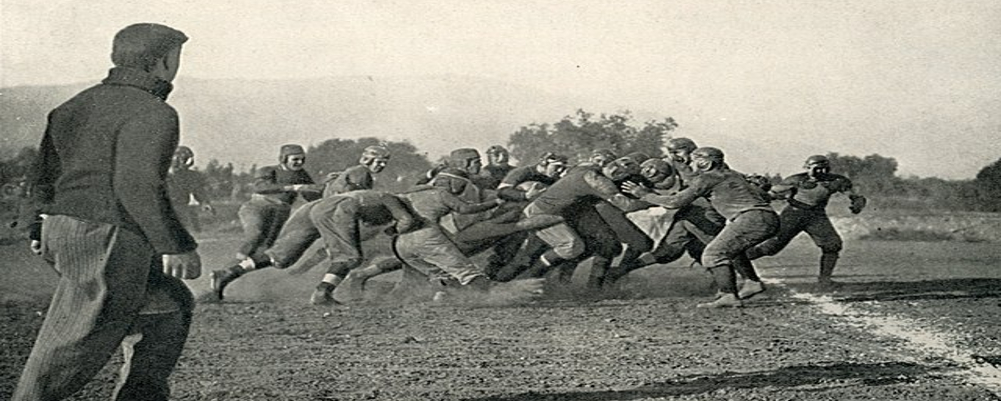Changes at the Top of the League
There was a shuffle of the top NFL brass even before the season started. League President Carl Storck, one of the NFL's founding members, stepped down to give way to former Notre Dame Four Horseman Star Elmer Layden. Layden became the NFL's first Commissioner, signing a contract promising $20,000 annually over informative years.
On April 5, Layden and company moved the NFL offices to Chicago.
Playoffs were integrated into the NFL only if two teams were tied at the end of the season. A sudden-death format was activated if a playoff was tied after four quarters.
Pennsylvania Shuffle
Pittsburgh Steelers owner Art Rooney Sr. was frustrated by the ill fate of his team's 1940 season after a 2-7-2 record. That previous season, he tried to change the fortunes of the team by changing the moniker from the Pirates to the Steelers, as we know them today, but this and personnel changes were to be fruitless.
Meanwhile, across the Keystone State, Rooney's longtime friend, Philadelphia Eagles owner Bert Bell, was suffering a similar frustration with his woeful 1940 club.
A way out arose to help settle Rooney's stomach from the financial impact of continual losing seasons. 26-year-old New York businessman Alexis Thompson, whose family wealth ironically came from the steel industry, wanted a new toy, so "Lex" offered Rooney many times what the franchise cost the Chief to start, $160,000.
A clever sequence of events then transpired in the following months. In late December 1940, the League approved the sale of the Steelers to Thompson at the owner's meeting. Rooney invested these newly found funds in buying half of the Eagles from Bell, who also needed the cash infusion after long-suffering years in the red.
Thompson changed the name of his new Pittsburgh club to the Pittsburgh Ironmen and hired Coach Greasy Neale. Secretly, Thompson Bell and Rooney had a master plan. Lex was planning on moving the team out of Steel City to Boston, while Art and Bert would make a statewide team called the Pennsylvania Keystone, splitting home games between Philly and Pittsburgh.
Washington owner George Preston Marshall entered the story. He did not want to see a statewide franchise and blew the whistle on the unhatched plot, rallying other owners to block the planned transactions of Rooney, Bell, and Thompson.
A new plan was needed since Thompson liked his team and coach but not the town, and Rooney wanted to return to the confines of his hometown. The newly accepted course of action was for the two franchises to trade cities and names. The Bell/Rooney-owned Eagles became the Pittsburgh Steelers, and the Thompson Ironmen became the new Philadelphia Eagles in April 1941. Leading to the April 3, 1941, Philadelphia Inquirer headlines to read, "Eagles Swap Franchise With Pittsburgh," and "Bert Bell, Players Quit Phila. ~ Pittsburgh Gridmen Come Here."
Pearl Harbor Attacks During NFL games
When the Japanese attacked Pearl Harbor on Sunday, December 7, 1941, the time on the East Coast was 12:55 PM. Three League games were underway, including one at the Polo Grounds as the Giants entertained cross-town rival the Brooklyn Dodgers on "Tuffy Leemans," tribute day. According to reports, the stadium Associated Press ticker tape machine started hammering out a message near halftime of the game, which read, "Airplanes identified as Japanese have attacked the American Naval Base at Pearl Harbor."
During commemorations for the former Giants star Leemans, the Public Address announcement boomed through the stadium, stating that all active military persons needed to report to their commanding officers. There did not seem to be any mention of the attack to make the players and those in attendance aware of why the soldiers were being called to base.
New York End Jack Lummus, who suited up for the game as a reserve, might not have known it then, but this would be the final NFL game he attended. Lummus joined the US Marine Corps and was one of the many American war heroes who died on the island of Iwo Jima a few short years later. Among his last words to surviving comrades was something that the New York Giants had lost a perfect end.
The New York Football Giant ended, and Marine was later posthumously awarded the Congressional Medal of Honor.
Meanwhile, at Griffith Stadium in the Nation's Capitol, a similar announcement to military and government officials echoed through the stands. Press members were encouraged to report to their employers immediately, but no one in attendance was told why these statements were made.
They soon discovered that the event involved the United States entering two theaters of war in a conflict on three continents.
Post Season
The timing of the Playoff OT rule was perfect because Western rivals, the Chicago Bears and Green Bay Packers, were tied after the last scheduled games for first place. The NFL's first divisional playoff was set. The game took place at iconic Wrigley Field, and the hometown Bears won 33-14 to earn the right to host the NFL championship game against the New York Football Giants. Once again, the Bears would make the Windy City patrons proud with a 37-9 victory.
Passing Leader: Cecil Isbell, 1479 Yds
Rushing Leader: Pug Manders, 486 Yds
Receiving Leader: Don Hutson, 738 Yds
Dominant Style of Play
The strategy and formational look of the 1941 game were different than what we would recognize based on the modern game. It was still in the era of single-platoon football, where substitutions were rare, and players staying out on the field from the initial whistle to the final gun was common.
The offense of choice was predominantly the use of the single-wing was still the popular choice but the success that the Bears had in the 1940 NFL Championship game, where they defeated the Washington Redskins handily at 73-0, had some starting to think about deploying another tactic the T-Formation. Clark Shaughnessy, then the head coach at Stanford, helped the Bears employ the formation to surprise the Washington eleven.


